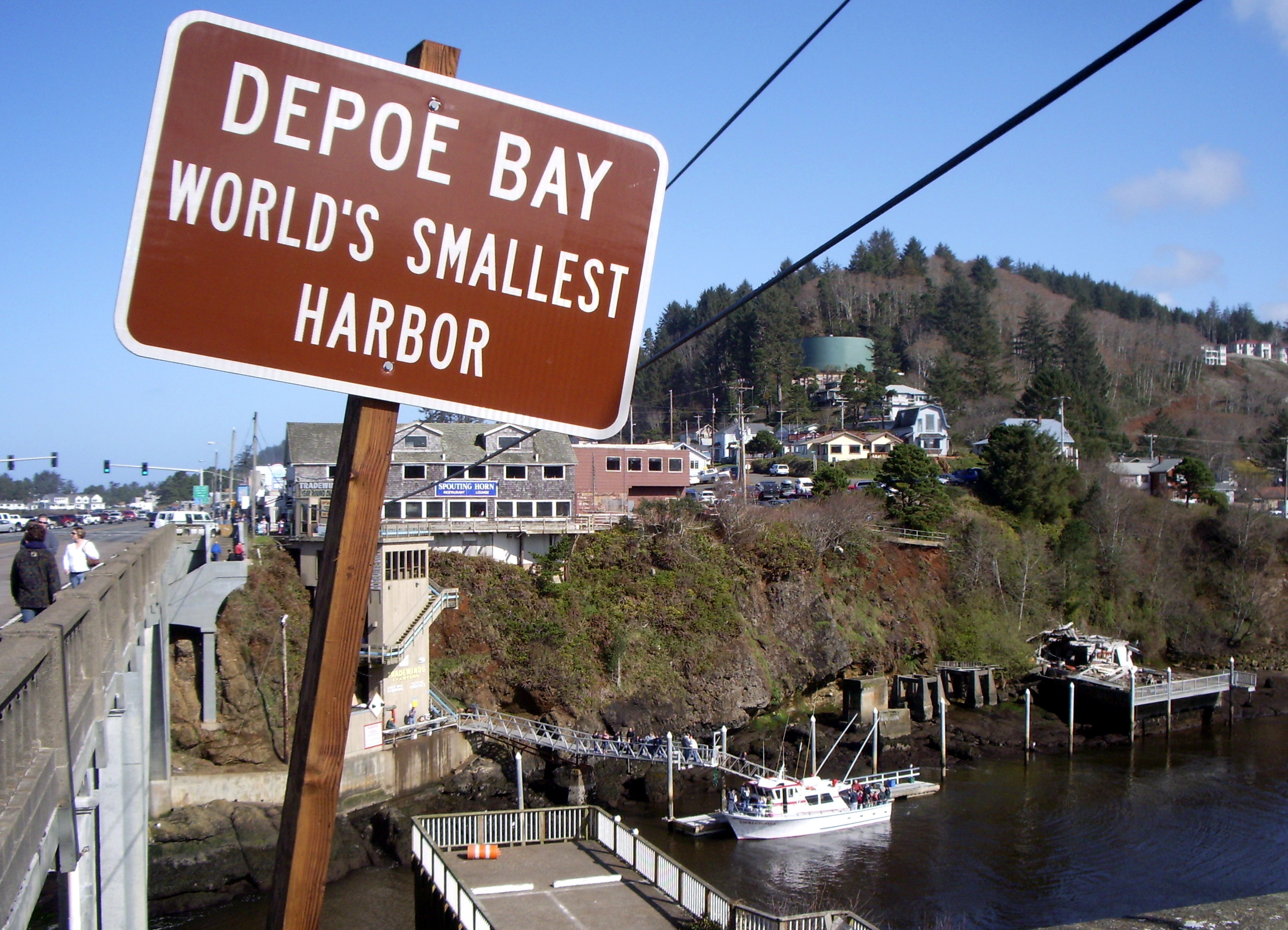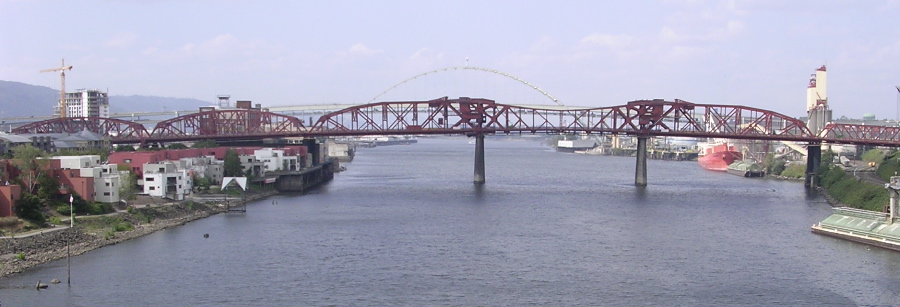|
Depoe Bay Bridge
The Depoe Bay Bridge is one of a series of significant bridges along the Oregon Coast Highway. The concrete arch bridge spans the mouth of Depoe Bay at milepost 127.61 with a main span, and a total length of . The bridge's designer was Conde McCullough who designed all of the 1920s bridges on the highway. The original bridge, completed in 1927, was only wide from curb to curb with no sidewalks, and was widened in 1940 with a similar arched concrete bridge immediately adjacent to the original. The added structure is sympathetic to the original and is included in the National Register of Historic Places listing. Description The bridge spans the narrow outlet of Depoe Bay with one long arch and three arched girders on one approach side, with a smaller arched girder on the other side. The bridge was built by the Kuckenberg-Wittman Company for $55,000. The deck features a decorative arched railing with details in the Art Moderne style popular at the time. The 1940 bridge joins the or ... [...More Info...] [...Related Items...] OR: [Wikipedia] [Google] [Baidu] |
Depoe Bay, Oregon
Depoe Bay is a city in Lincoln County, Oregon, United States, located on U.S. Route 101 on the Pacific Ocean. The population was 1,398 at the 2010 census. The bay of the same name is a harbor that the city promotes as the world's smallest navigable harbor. History Depoe Bay was named for Siletz Indian Charles "Charley" Depot who was originally allotted the land in 1894 as part of the Dawes Act of 1887. There are conflicting accounts of the origin of his name. One says he was given the name "Depot Charley" for working at the military depot near Toledo, Oregon. The family was later known as "DePoe". His original tribal affiliation was Tututni. In 1975, the fishing trip sequence in '' One Flew Over the Cuckoo's Nest'' was filmed in Depoe Bay. In 1983, the harbor sequence in '' Hysterical'' was filmed in Depoe Bay, with the Depoe Bay Bridge prominent in the background. In 2008, restaurant scenes from ''The Burning Plain'' were filmed in Depoe Bay, at the Tidal Raves restaurant. ... [...More Info...] [...Related Items...] OR: [Wikipedia] [Google] [Baidu] |
Road Bridges On The National Register Of Historic Places In Oregon
A road is a linear way for the conveyance of traffic that mostly has an improved surface for use by vehicles (motorized and non-motorized) and pedestrians. Unlike streets, the main function of roads is transportation. There are many types of roads, including parkways, avenues, controlled-access highways (freeways, motorways, and expressways), tollways, interstates, highways, thoroughfares, and local roads. The primary features of roads include lanes, sidewalks (pavement), roadways (carriageways), medians, shoulders, verges, bike paths (cycle paths), and shared-use paths. Definitions Historically many roads were simply recognizable routes without any formal construction or some maintenance. The Organization for Economic Co-operation and Development (OECD) defines a road as "a line of communication (travelled way) using a stabilized base other than rails or air strips open to public traffic, primarily for the use of road motor vehicles running on their own wheels", which i ... [...More Info...] [...Related Items...] OR: [Wikipedia] [Google] [Baidu] |
Historic American Engineering Record In Oregon
History (derived ) is the systematic study and the documentation of the human activity. The time period of event before the invention of writing systems is considered prehistory. "History" is an umbrella term comprising past events as well as the memory, discovery, collection, organization, presentation, and interpretation of these events. Historians seek knowledge of the past using historical sources such as written documents, oral accounts, art and material artifacts, and ecological markers. History is not complete and still has debatable mysteries. History is also an academic discipline which uses narrative to describe, examine, question, and analyze past events, and investigate their patterns of cause and effect. Historians often debate which narrative best explains an event, as well as the significance of different causes and effects. Historians also debate the nature of history as an end in itself, as well as its usefulness to give perspective on the problems of the p ... [...More Info...] [...Related Items...] OR: [Wikipedia] [Google] [Baidu] |
Bridges By Conde McCullough
A bridge is a structure built to span a physical obstacle (such as a body of water, valley, road, or rail) without blocking the way underneath. It is constructed for the purpose of providing passage over the obstacle, which is usually something that is otherwise difficult or impossible to cross. There are many different designs of bridges, each serving a particular purpose and applicable to different situations. Designs of bridges vary depending on factors such as the function of the bridge, the nature of the terrain where the bridge is constructed and anchored, and the material used to make it, and the funds available to build it. The earliest bridges were likely made with fallen trees and stepping stones. The Neolithic people built boardwalk bridges across marshland. The Arkadiko Bridge (dating from the 13th century BC, in the Peloponnese) is one of the oldest arch bridges still in existence and use. Etymology The ''Oxford English Dictionary'' traces the origin of the wo ... [...More Info...] [...Related Items...] OR: [Wikipedia] [Google] [Baidu] |
Open-spandrel Deck Arch Bridges In The United States
A spandrel is a roughly triangular space, usually found in pairs, between the top of an arch and a rectangular frame; between the tops of two adjacent arches or one of the four spaces between a circle within a square. They are frequently filled with decorative elements. Meaning There are four or five accepted and cognate meanings of the term ''spandrel'' in architectural and art history, mostly relating to the space between a curved figure and a rectangular boundary – such as the space between the curve of an arch and a rectilinear bounding moulding, or the wallspace bounded by adjacent arches in an arcade and the stringcourse or moulding above them, or the space between the central medallion of a carpet and its rectangular corners, or the space between the circular face of a clock and the corners of the square revealed by its hood. Also included is the space under a flight of stairs, if it is not occupied by another flight of stairs. In a building with more than one floor, ... [...More Info...] [...Related Items...] OR: [Wikipedia] [Google] [Baidu] |
Public Works Administration In Oregon
In public relations and communication science, publics are groups of individual people, and the public (a.k.a. the general public) is the totality of such groupings. This is a different concept to the sociological concept of the ''Öffentlichkeit'' or public sphere. The concept of a public has also been defined in political science, psychology, marketing, and advertising. In public relations and communication science, it is one of the more ambiguous concepts in the field. Although it has definitions in the theory of the field that have been formulated from the early 20th century onwards, and suffered more recent years from being blurred, as a result of conflation of the idea of a public with the notions of audience, market segment, community, constituency, and stakeholder. Etymology and definitions The name "public" originates with the Latin '' publicus'' (also '' poplicus''), from ''populus'', to the English word 'populace', and in general denotes some mass population ("the p ... [...More Info...] [...Related Items...] OR: [Wikipedia] [Google] [Baidu] |
Bridges In Lincoln County, Oregon
A bridge is a structure built to span a physical obstacle (such as a body of water, valley, road, or rail) without blocking the way underneath. It is constructed for the purpose of providing passage over the obstacle, which is usually something that is otherwise difficult or impossible to cross. There are many different designs of bridges, each serving a particular purpose and applicable to different situations. Designs of bridges vary depending on factors such as the function of the bridge, the nature of the terrain where the bridge is constructed and anchored, and the material used to make it, and the funds available to build it. The earliest bridges were likely made with fallen trees and stepping stones. The Neolithic people built boardwalk bridges across marshland. The Arkadiko Bridge (dating from the 13th century BC, in the Peloponnese) is one of the oldest arch bridges still in existence and use. Etymology The ''Oxford English Dictionary'' traces the origin of the wo ... [...More Info...] [...Related Items...] OR: [Wikipedia] [Google] [Baidu] |
Bridges Completed In 1927
A bridge is a structure built to Span (engineering), span a physical obstacle (such as a body of water, valley, road, or rail) without blocking the way underneath. It is constructed for the purpose of providing passage over the obstacle, which is usually something that is otherwise difficult or impossible to cross. There are many different designs of bridges, each serving a particular purpose and applicable to different situations. Designs of bridges vary depending on factors such as the function of the bridge, the nature of the terrain where the bridge is constructed and anchored, and the material used to make it, and the funds available to build it. The earliest bridges were likely made with fallen trees and stepping stones. The Neolithic people built boardwalk bridges across marshland. The Arkadiko Bridge (dating from the 13th century BC, in the Peloponnese) is one of the oldest arch bridges still in existence and use. Etymology The ''Oxford English Dictionary'' traces ... [...More Info...] [...Related Items...] OR: [Wikipedia] [Google] [Baidu] |
Conde McCullough
Conde Balcom McCullough (May 30, 1887 – May 6, 1946) was an American civil engineer who is primarily known for designing many of Oregon's coastal bridges on U.S. Route 101. The native of South Dakota worked for the Oregon Department of Transportation from 1919 to 1935 and 1937 until he died in 1946. McCullough also was a professor at Oregon State University. Early life Conde McCullough was born in Redfield, South Dakota, on May 30, 1887.His Life: From Iowa State to Oregon State. Oregon State University: Civil & Construction Engineering, accessed October 8, 2007. In 1891, he and his family moved to where his father died in 1904. McCullough then worked at various jobs t ... [...More Info...] [...Related Items...] OR: [Wikipedia] [Google] [Baidu] |
List Of Bridges On The National Register Of Historic Places In Oregon
This is a list of bridges and tunnels on the National Register of Historic Places in the U.S. state of Oregon. It includes a number of viaducts which are considered bridges. A list of bridges, tunnels, and viaducts of the Historic Columbia River Highway is included. __TOC__ Gray shading indicates that a structure has been removed from the Register. Often the road listed in the "location" column now parallels the bridge on a new one, and the old bridge is closed to traffic. Bridges and tunnels besides in Historic Columbia River Highway Historic Columbia River Highway bridges and tunnels These are contributing structures in the Historic Columbia River Highway, which was listed on the National Register of Historic Places in 1983, and was further designated a National Historic Landmark District in 2000. With See also *List of Oregon covered bridges *List of bridges in the United States References * (does not include places no longer listed)Oregon National Register List No ... [...More Info...] [...Related Items...] OR: [Wikipedia] [Google] [Baidu] |



.jpg)


.jpg)
